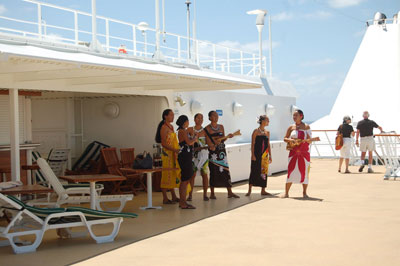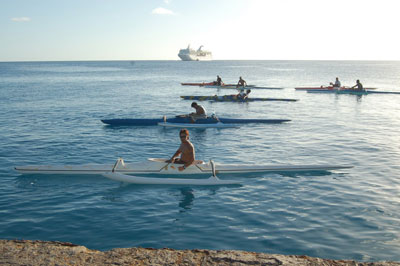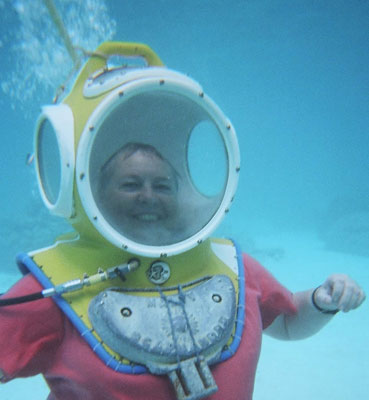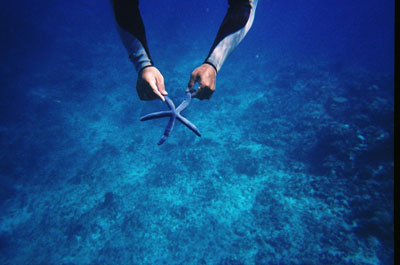Comparing two cruises through French Polynesia on the ‘Paul Gauguin’
by Judith Anshin, Contributing Editor
For many years I had wanted to sail in French Polynesia on the M/S Paul Gauguin. I was attracted by my love of the sea and snorkeling and by the ship’s reputation for the pampering of its passengers. So I chose an itinerary, in late August ’09, that would give me maximum time to snorkel.
About the ship
I booked my 19-day trip — covering the Cook, Society and Austral islands and the Tuamotus — through Vantage Deluxe World Travel (Boston, MA; 800/322-6677) because I had a credit from a previous trip with them. For a single cabin on the lowest deck, including international air from Los Angeles, I paid $8,029, which included $493 in port taxes and security fees, an advance-purchase discount of $500 and a past-traveler discount of $234.
Cabins on the higher decks are more expensive. I met a woman who had a single room on a high deck who paid $20,000 for her cruise. However, I discovered that, with the exception of having a balcony, each of those rooms were of the same basic size and configuration as mine.
As the Paul Gauguin is a luxury cruise ship, prices are high, but the fare is all inclusive, covering all alcohol (except for specialty or high-end liquors) and gratuities. The service was extremely good, with a high ratio of staff to passengers.
I was very pleased with everything about the ship, and since it carries a maximum of 332 guests, it was easy to meet many of my fellow passengers.
The dining room offered open seating, with many large tables which couples or singles could join, affording a good opportunity to get to know others. I met several people with whom I am still in touch and with whom I hope to travel again.
Beginning in Papeete
My only disappointment with the trip was the loss of two ports of call: Rarotonga, one of the Cook Islands, and Tubuai, belonging to the Austral Islands. Staff on board said that, because of high seas, on only one out of three sailings is the ship able to call at Rarotonga, but nothing to that effect is in any of the literature about the trip.
The same wind and high seas caused the cancellation of our stop at Tubuai. Instead, the captain added a call in Raiatea in the Society Islands.
Spending two nights in Papeete, on the island of Tahiti, before the cruise was helpful in recovering from the long travel day from the US, and our one night there at the end of the cruise meant we didn’t have to rush to the airport for the overnight flight home. However, I found nothing outstanding about Papeete.
There was a nice market with a combination of food and tourist items, but prices were extremely high. This was the case throughout French Polynesia.
Vantage offered tours of the island both before and after the cruise. I took one at the end but felt it was overpriced ($79 for six hours). Most of the islands in the area look so much alike that, often, a tour of just one is sufficient.
I was surprised to learn that a number of people in our group had been on multiple trips on the Gauguin. One couple I met was on their 11th voyage and another, their 13th! Of course, they were a good source of information, and it seemed all of the ship’s staff knew them.
Underwater adventures
One couple with whom I became friends was on their third voyage on the Gauguin, and they arranged for a boat, themselves, for a snorkeling excursion at Aitutaki, Cook Islands, so I joined them and another couple. It was our first snorkeling excursion of the trip, and it turned out to be quite a good one.
The ship offers numerous excursions at each port, but prices tend to be quite high. Our voyage also featured an onboard naturalist, Bobbie Verdegaal, who offered a few snorkeling excursions at more reasonable prices.
My last snorkeling excursion of the trip was with Bobbie and it was really wonderful. We used the ship’s beacher, with a ramp that normally goes down onto the sand for a beach landing. In the water, it can be lowered only enough to allow passengers to slip off into the sea, but jumping back in was tricky for those of us less agile than the young Ms. Verdegaal!
At almost every other snorkeling excursion during the cruise, the tour operator would throw bread and food to attract more fish for the snorkelers to see. This is not a good practice, so Bobbie did not do that. But as soon as our beacher stopped in the water, many stingrays swam over to us expecting to be fed. Once they realized there was no free food, some of them swam away.
The best part of the excursion, however, were the tiki heads. In the 1960s, a local artist in Moorea felt there wasn’t enough appreciation of his carved stone tiki heads, so he loaded them onto a barge and dropped them overboard in the lagoon! They are scattered around, some with coral growing on them.
Swimming around to find them was great fun. I got so engrossed with seeing all of them that Bobbie had to send her helper to tell me to come back to the boat so we could leave. I was sorry the excursion was over but happy not to be left behind!
Bobbie gave lectures most days, teaching us about the sea and the coral reefs. All of us were very pleased she was on board.
More spectacular snorkeling
I had another outstanding snorkeling adventure in Rangiroa in the Tuamotus. Rangiroa comprises a series of islets (called motus) around a lagoon, creating the largest atoll in Polynesia and, in fact, one of the largest atolls in the world.
We were anchored there for two nights. On the first day, I joined some friends from the ship for an afternoon of snorkeling off the beach. Though there was a lot of coral, the fish were scarce. When I returned to the ship, I immediately signed up for the next day’s excursion to the “aquarium of Rangiroa.”
This snorkeling spot was not too far from one of the passages into the lagoon, so two boats were used to mark the area in which we could safely snorkel without fear of getting caught in the current going out to the sea. Thanks to Bobbie’s earlier lectures, I was able to identify many of the fish I saw, and the time at this spot went too quickly.
For nonsnorkelers or divers, in both Bora Bora and Moorea there were underwater walking excursions. Since I don’t scuba dive, I thought this might be a lot of fun, so I signed up for the Moorea excursion.
Four people were taken down at one time outfitted with large, old-fashioned-looking diving helmets with attached air hoses. The lead diver then showed participants a variety of corals and fish, including stingrays, which he fed. The stingrays throughout Polynesia seemed to be so used to people that they swam quite close.
I never felt afraid of any fish or the rays but followed the admonition to be aware of where the ray’s stinger was located and to avoid touching that area. Touching the rest of the body was okay — and fun!
Other onboard activities
Although snorkeling and diving are main activities aboard the Gauguin, if you don’t do either there are still plenty of activities to choose from. Numerous land excursions are available every day in port, and, while at sea, there are lectures, movies, games and more.
There is also a group of young local women known as Les Gauguines on board, and they hold classes on a number of subjects, including making shell jewelry and weaving pandanus leaf bookmarks.
We were lucky enough on our sailing to have two lecturers on board who were extremely interesting. I made sure to never miss one of their lectures.
Professor Mark Eddowes, a field archaeologist from New Zealand, has worked for the Ministry of Culture in Tahiti for 20 years. His lectures and pictures made the history and culture of the area come alive.
Jon Bowermaster is a six-time grantee of National Geographic’s Expeditions Council who had recently completed a project in which he and his teams used sea kayaks to circle the globe. His films of the Antarctic navigation were breathtaking. His storytelling ability and pictures made his lectures a highlight of the trip, for me.
Back for more
There was a lot of talk among the passengers on this trip about possible changes to the Gauguin in 2010, as the ship’s lease with Regent Seven Seas Cruises was to expire at the end of 2009. The captain assured everyone on the last night that nothing would change beyond the logo on the ship’s funnel.
The new lessee, operating the ship as Paul Gauguin Cruises (Bellevue, WA; 800/848-6172), is the owner of the InterContinental hotels in the Society Islands, and, indeed, a few changes were made, as I found out when I sailed on the Gauguin again in May 2010, booking again through Vantage. Joining a couple I met on the previous voyage, I took advantage of a special deal being offered, one which eliminated the usual single supplement. I stayed in the cabin right next door to the one I had in 2009, but this time I paid only $3,200, excluding international air.
This sailing was less than half full, and special prices offered in the week before the sailing brought at least eight more singles on board.
I continue to receive many e-mails advertising cruises on the Paul Gauguin, but, so far, I have not seen another voyage with the single supplement eliminated. I find this unfortunate, as, during these difficult economic times for travel companies, it could make a difference in the number of passengers booking.
The May sailing was only two weeks instead of the 19 days I enjoyed in 2009, and, while it also included Moorea and Bora Bora, the ship dropped anchor at different locations than it did on my previous cruise.
New adventures
In Bora Bora, the beacher took us to a motu where we could swim, snorkel or just relax, and the ship set up a bar with hard and soft drinks, water and snacks.
In Aitutaki, we were unable to rent the same boat we had rented the previous year because of damage to it from the cyclone that had hit Atitutaki and parts of Fiji earlier in the year. Instead, there was a bus that, for NZD20 ($15.50), took passengers to two different beaches. My friends and I went to the first one and enjoyed good snorkeling right off the beach.
Again, we were unable to land at Rarotonga, so I think I will have to fly there someday if I ever want to see it. Because we bypassed this port, we arrived in Tonga on a Sunday. The very religious islanders do not work on Sundays, including Customs officers, so we had to drop anchor and look longingly at the island until Customs could clear us the next morning.
The two best snorkeling excursions on this trip were in Tonga and in Malolo, Fiji. My friends and I had booked a snorkeling adventure in Tonga with a company I found online, Dive Vava’u (phone +676 70492). We paid $45 per person for about four hours.
Thank goodness for our strong Tongan helper/guide because the swells there were quite high and the current very, very strong. My snorkel got swamped endless times, so I quickly became quite adept at blowing out the saltwater, with only a small amount getting into my mouth.
The first stop we made, 35 minutes out from shore, was pretty uncomfortable, so after an hour we decided to head to another spot in the hopes that it might be calmer. But first I had to get back on the boat — the hardest part of every snorkeling trip.
With the boat bobbing like mad and my being thrown about by the swells, I grabbed onto the swim platform and the Tongan guide basically threw my legs up on the platform! I wasn’t the only one having trouble, so I didn’t feel like such a klutz.
At the second stop, the swells were slightly smaller but the current was just as strong. The Tongan man finally took my hand and dragged me along behind him, for which I was immensely grateful.
Fiji highlights
Our first port in Fiji was Savusavu and it was good for both shopping and snorkeling. I shopped in the small town in the morning and spent the afternoon snorkeling at a resort to which Jean-Michel Cousteau has lent his name.
My friends and I were invited to join the Gauguin’s captain in his Zodiac for a quick trip to the resort, thus saving us a hot taxi ride. There was a large amount of coral and fish right off the resort’s beach, and a pier with a nice ladder going into the water made it easy to get in and out of the water.
The last stop in Fiji was at Malolo Island, where the tenders took us to the Musket Cove Resort to swim, snorkel or relax. This turned out to be the best snorkeling I had ever done.
For the equivalent of $11, one could go to a coral area quite a ways offshore. I had missed a large group departure, so the resort staff asked an older man standing nearby if he would take me out for the usual hour and he did. MoMo dropped me off at one area, told me to go in “that direction” and said he would pick me up there later.
I headed out and was stunned by the variety and amount of coral and fish. I saw fish I had never seen before and one I was never able to identify, even with the help of the divemaster on the Gauguin.
The water was exceptionally clear, and each time I thought it couldn’t get any better, it did! I could have happily spent the entire day out there.
When the time was up, MoMo returned and told me to hang onto the side of the boat so he could take me to shallow water, where it would be easier to get into the boat. When my hands kept slipping, he gave me a rope to hang on to and I bodysurfed alongside the boat. That was the most fun I have ever had in the water!
I returned to the ship for lunch and told everyone I knew that they had to find MoMo to take them out to snorkel because it was such an incredible experience. Several of them followed my advice and found the snorkeling as exciting as I had.
Measuring up
I found the changes on the Gauguin under the new lessee to be quite minimal. Captain Zupan was much more outgoing than the ship’s captain in 2009, and he was very interesting to talk with. There were other changes in personnel, but that was probably due to normal rotations. The divemaster was the same, and the many waiters, headwaiters, cooks and Les Gauguines all seemed to be the same.
The staff really make the Gauguin the special ship that it is. Everyone is so friendly and helpful, remembering both you and your preferences in drinks and food.
Kelly, the wine steward in the main dining room, always brought me a special red wine because on the first night I had said I didn’t like white wine. That night I also decided to try a Godiva chocolate liqueur with my dessert and decaf coffee. I said that it was so good, I would have it every night, and every night as dessert was being served Kelly appeared with my liqueur!
With the small number of passengers on this trip, the interaction with the waiters and other staff was more easygoing. As an animal lover and a vegetarian, I would close my eyes when a whole young pig or other animal was being displayed and carved at the lunch buffet, so when the waiter saw me coming he put the lid down over the animal and gave me a big smile. It is little touches like these that make being a passenger on the Gauguin such a treat.
As soon as I either find a roommate or the single supplement is eliminated on an itinerary that is new to me, I will certainly be back aboard.






